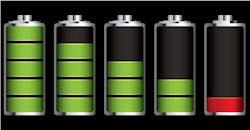Why is Low Iq So Essential in Battery-Powered Applications?
This article is in TechXchange: Why Low Iq is the Smart Thing to Do
Members can download this article in PDF format.
What you'll learn:
- Reasons behind the critical nature of low Iq in battery-powered apps.
- Types of low-Iq battery applications.
Just about every one of us has some sort of a portable handheld and/or ear communication/music device—MP3 players, Bluetooth devices, smartphones, tablets, smart watches, ear buds, and so much more. These smart/connected devices all have low power operation with batteries, which can allow for fairly long operating times for users. Quiescent current (Iq), a key parameter in these devices, must be minimized to achieve high performance while maximizing operation time.
It's necessary to extend power savings when the above-mentioned battery-powered devices are in a passive state. Iq is the level of current used, for example, when an IC becomes enabled, but with no switching action or support of any kind of load current.
Let’s take as an example an Internet of Things (IoT) smart sensor node. These types of nodes are prime facilitators of smart industrial and automation on the factory floor. A low-power, smart sensor node is composed of sensors, microcontroller, power management, and transceiver. The no-load Iq is the largest factor in overcoming low-power duty-cycled systems. A low Iq will lengthen battery life and reduce power consumption.
Designers can determine the total Iq drawn from the battery. Always-on functions and leakage sources from capacitors, resistors, and inductors must be considered as part of the total Iq as well.
Switching converters are a different story. The Iq here may include a power-saving mode that will enable a period of no switching action which will greatly help the average Iq.
Designers can estimate battery life for a frequently duty-cycled, low-power design in a standby mode, which would be greater than 99.9% of the time:
Battery lifetime = Battery capacity/ (II(standby) + I(battery leakage))
Examples of Low-Iq Battery Applications
Battery-operated wearables
Within the spectrum of battery-operated devices, wearables present a particularly difficult challenge to battery lifetime. These kinds of IoT node devices may sit on shelves in stores and distribution houses, like Amazon, until the time comes to get them into a customer’s hands. When users activate these devices, they will typically spend most of their time in a standby mode, awakening periodically to transmit data to the cloud or perform some type of action.
One option is to use a power-management integrated circuit (PMIC). The PMIC device enables the system to function in various operating modes, depending on load conditions. Such devices may be configured to operate in normal mode, sleep mode, standby mode, power-saving mode, hibernation mode, and shutdown mode. The device power supply is able to switch between these modes automatically, based on the load demand.
The device will typically draw current that fluctuates over a very wide range, going from a few milliamperes, when in a normal working mode, down to just a few nanoamperes when in a sleep mode. Devices with such low-power working modes will save a great deal of power that also helps support longer battery life.
Load switches
Driver circuits in load switch applications can make a significant difference in lowering bias-current levels to less than 0.1 nA in the ON state. Two major load-switch application areas are wearables and IoT devices.
Amplifiers
Class A amplifier
The power loss of transistors in the absence of an input signal is the product of its Q-point current and voltage:
PDQ = ICQVCEQ
The dc quiescent power in the above equation is the maximum power that a Class A amplifier is able to handle. The power rating of a transistor will need to be larger than this value.
The Class A amplifier Iq consumption in a battery-powered circuit design should be as low as possible in order to extend the battery’s life. Class A amplifiers have the general property that the output device(s) will always carry a significant current level, leading to a large quiescent current. Tradeoffs must be made in such a design if the lowest quiescent current is desired.
There’s only one method for the class A amplifier to deliver power to the load: Maintain a quiescent current equal to the peak current for that load.
Class B power amplifier
A Class B power amplifier bias effectively has a zero quiescent current, leading to very-low-level power consumption in the absence of an input signal. This makes the output transistor conduct only for a half of each signal waveform cycle, which causes output signal distortion. The transistors don’t have a base bias, so they will not begin to conduct until their base/emitter voltage reaches approximately 0.6 V.
Class AB amplifier
A class AB amplifier, with a push-pull output circuit, is a bit less efficient than a class B amplifier since it has only a small quiescent current flowing. Its transistors are biased just a bit above cutoff.
Amplifier transient response in low-Iq devices
Low-quiescent-current devices will exhibit longer response times since their internal parasitic capacitors must be charged to a new operating point with some less degree of current. In a worst-case scenario, a step from no load to the maximum allowed load current will occur.
These cases will make it necessary to reactivate circuits that were deactivated or reduced in power, which causes an additional delay. Settling time also will degrade due to reduced bias conditions. In a conventional, differential input stage, the gain will reduce linearly with the bias current. This will lead to a reduction in bandwidth and increased settling time.
Low-Dropout (LDO) Regulators
A device’s battery life depends greatly on the load conditions while in operation. LDOs with a low quiescent current are a simple solution to help boost the runtime of any battery-operated circuit.
Summary
Low-quiescent-current ICs are becoming ubiquitous in battery-operated applications such as smoke detectors (with battery backup), wearables, health monitors, amplifiers, and load switches, just to name a few. Thus, LDO power regulators are in high demand in today’s power-management market.
LDO power devices are paramount in minimizing quiescent current, especially in myriad low-power designs that have a battery as the power source. Battery lifetimes are extending from two to five years and even higher in many cases. In the end, low-Iq designs are leading the way to a greener environment with reduced carbon emissions.
Read more articles in TechXchange: Why Low Iq is the Smart Thing to Do
References
1. Low quiescent current (IQ): Enabling extended battery life without compromising system performance or solution size, Electronic Design/Texas Instruments webinar.
2. “LDO basics: introduction to quiescent current,” Wilson Fwu.
3. “Overcoming Low-IQ Challenges in Low-Power Applications,” K. Kunz, S Reithmaier.
4. “IQ: What it is, what it isn’t, and how to use it,” Chris Glaser.

